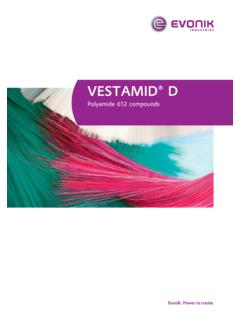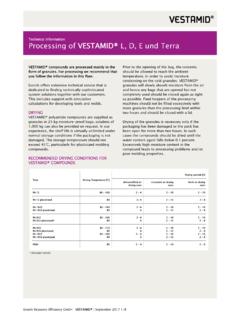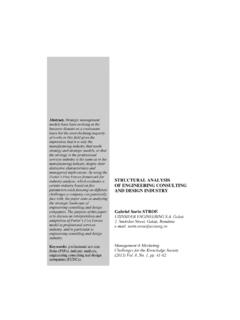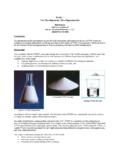Transcription of FOR A LONG-LASTING MARRIAGE - vestamid.com
1 1 High-Performance Polymers in plastic-rubber composites FOR A LONG-LASTING MARRIAGE2We have the right materials to take you to the top Evonik, the creative industrial group from Germany, is one of the world leaders in specialty chemicals. The company benefits specifically from its innovative prowess and integrated technology platforms. Evonik is active in over 100 countries around the world with more than 35,000 High Performance Polymers Business Line focus on manufacturing customized products and systems. For over 50 years, the business line has been producing high performance polymers.
2 With its line of specially modified compounds adhesive-free plastic-rubber composites can be realized in a one- or two-step process achieving cost savings of up to 30% depending on plant-specific Composites Two Approaches Suitable Compounds Polyamides VESTAMID Polyphenylene Ether VESTORAN 3468123 Hard-soft compositesWherever rubber components must be fastened or fixed, composites consisting of a hard component and an elastomer perform well. They represent an important sector of the rubber industry. Such composites are found in a wide variety of applications,for example, as shock absorbing bearings in the chassis of motor vehicles, buffers or reinforcedseals in engines and , hard components consisted of metal composites.
3 To reduce weight, particularly in vehicles, more and more metal components are being replaced by suitable plastic parts wherever possible. This has two additional advantages: Plastics do not corrode and can be efficiently processed into very complex moldings by injection molding. However, they must be dimensionally stable at the usual vulcanization temperatures of 160 to 190 C. The manufacture of such complex parts from metal is very expensive. The use of plastics in the design of complex components provides the designer and compo-nent developer with much greater the long -term function of composites, particularly under dynamic stress, the adhesion between the hard component and the soft component of the composite is an important criterion.
4 It is usually achieved by adhesives. Combi-nations of all standard rubber types with most metals and simple plastics are possible. Besides additional process steps for applying the adhesives, protective measures against emissions of the usual solvents and their environmentally correct disposal are without adhesivesBy contrast, the patented plastic-rubber composite process obviates adhesives. Stable, permanent bonds to suitable rubber blends can be produced without pre-treatment using specialty compounds of the VESTAMID (polyamide 612, polyphthalamide) and VESTORAN (polyphenylene ether) A: The adhesion is based on seve-ral mechanisms.
5 When the combination of VESTORAN and SBR or SBR-containing blends is used, (poly)styrene molecules interdiffuse in the interface. As a result, the substrates are welded B: The composite of VESTORAN with peroxidic cross-linked EPDM consists of stable carbon-carbon bonds formed by C: In the case of the VESTAMID types, in combination with XNBR, peroxidic cross-linking produces not only carbon-carbon bonds but also amide groups, which ensure permanent type of the very stable bond of fluororubber to polyamides is not yet completely understood.
6 An ionic reaction with the acid modified rubber could be ABonding of polyphenylene ether to SBR by diffusion of styrene segmentsSBRPPEEPDMPPEXNBRPAB onding mechanismFIGURE BRadical bonding of polyphenylene ether to EPDM by peroxidesFIGURE CRadical bonding of polyamides to XNBR by peroxides and amide groupsPLASTIC-RUBBER COMPOSITES34 Process steps for compositesThe one-step processIf there is little or no difference be-tween cooling time and vulcanization time, the one-step process is an option. By obviating adhesives, the composites can be manufactured in a common tool without intermediate steps, similarly to the two-component injection molding process.
7 To accomplish this, the injec-tion molding machine must be equipped with a rubber cylinder and a thermoplastic cylinder. Each cavity, that is, the thermo-plastic cavity and the rubber cavity, is situated in one half of a common tool. The plastic part is manufactured in the cold half of the tool. It is then trans-ferred, for example, with an index plate, transfer handling, or rotation molding into the hot half. Here the rubber formulation is applied and vulcanized. At the same time a new plastic molding is formed in the cold half. After the finished composite is dumped from the hot half, the cycle starts two-step processThe two-step process is almost identi-cal with the conventional production of rubber-metal and plastic-rubber compo-nents.
8 The plastic part is manufactured separately or supplied by an injection molder. The rubber compound is applied to this insert and vulcanized. However, the intermediate step of applying the adhesives is process is particularly useful when the vulcanization time is substantially longer than the cooling time of the associated plastic component. The two process steps can be optimally designed independently of each other. Investments in new machines are not on existing technical and plant conditions, two processes are available for manufacturing adhesive-free manufacturing process can be largely automated by eliminating adhesives.
9 Repeated handling of the parts is obviated. Thus, several sources of error are eliminated and the reject rate decreases. Depending on plant-specific conditions, cost savings of up to 30% can be comparing costs between the conventional process and the K&K process, we provide a cost estimate sheet upon re-quest. Simply get in touch with the specified OMPOSITE IN A ONE-STEP PROCESSM anufacturing of the hard componentsPLASTIC-RUBBER OMPOSITE IN A TWO-STEP PROCESSM anufacturing of the hard componentsTemporarily storage1 CONVENTIONAL PROCESSM anufacturing of the hard componentsTemporarily storage1 TWO APPROACHES45 Applying and vulcanizing of the rubber1 Applying and vulcanizing of the rubber2 DegreasingApplication of a primer and/oran adhesiveDryingApplying and vulcanizing of the rubber2456 Manufacture of a plastic-rubber composite in the
10 One-step process56S U I TA B L E COMPOUNDS Evonik manufactures and sells various polymers suitable for the adhesive-free plastic-rubber composites process. The polyamide 612 products are named VESTAMID D, the polyphthalamide (PPA) grades VESTAMID HTplus, and the polyphenylene ether (PPE) compounds are supplied under the brand VESTORAN .67 RubberVESTORAN (PPE)V E S TA M I D (PA 612)V E S TA M I D HTplus(PPA)A E M/AC M AAEPDMPPPFPM B I S/P/AB I S/P/AHNBR PPNR/SBRS SBRS SBR/NBRS VMQPPPXNBR P*S = Sulphur, P = Peroxide, A = Amine, BIS = Bisphenol* under evaluationCompoundFillerCombined withCross-Linking SystemApplicationsVESTORAN 1900 SBR, NR/SBR,NBR/SBR, EPDMS ulfur,peroxideVibration absorbers,shock absorbing bushings, reinforced profiles, sealsVESTORAN 1900GF2020% glass fibersVESTAMID X709920% glass fibersXNBR, HNBR,AEM, FPMP eroxide, bisphenol,amineOil-resistant seals, moldings, pencil coil ducts.





